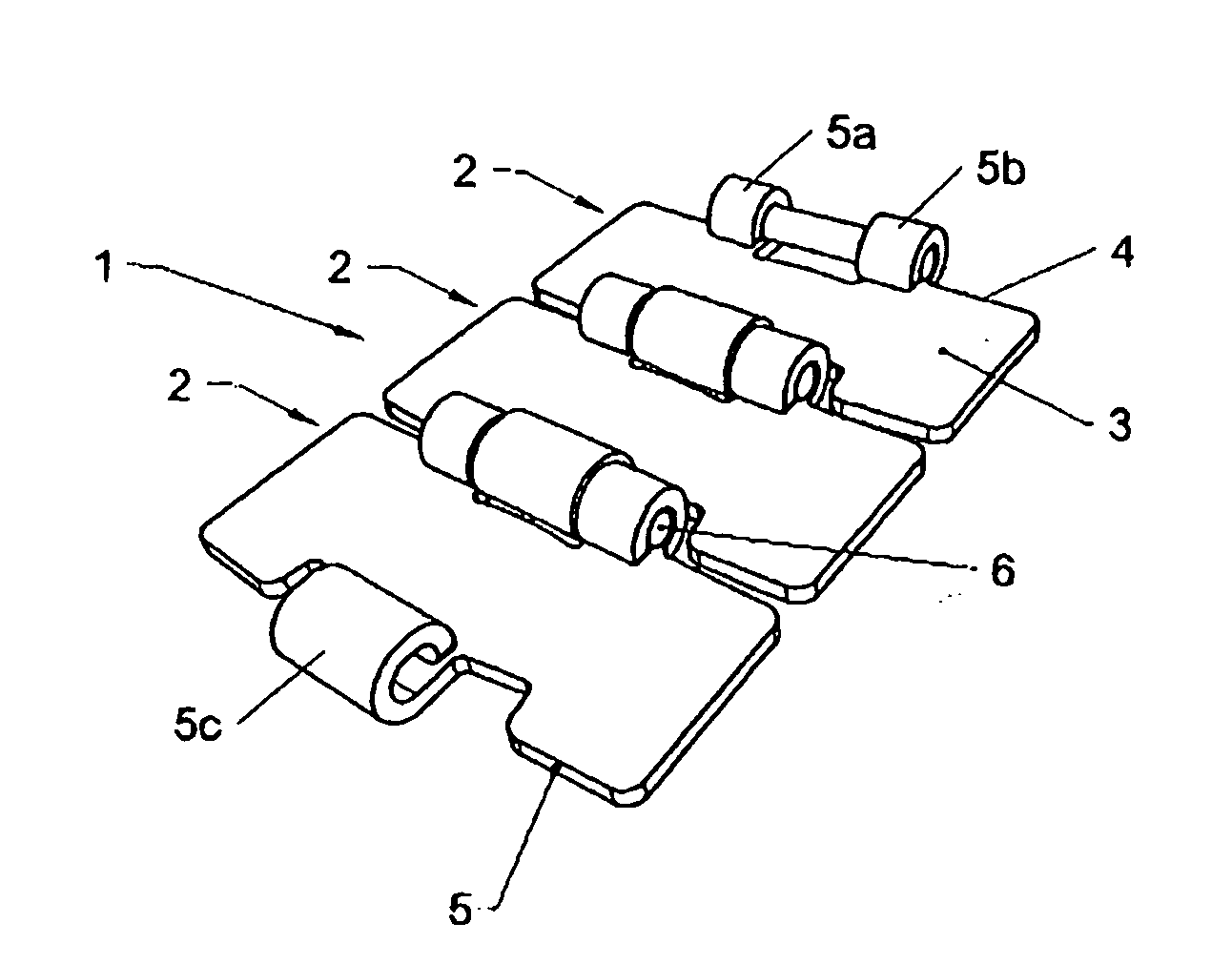Chain pin for hinge conveyor chains
a technology of hinge conveyor chains and chain pins, which is applied in the direction of driving chains, conveyors, packaging, etc., can solve the problems of abrasive wear of the pins of conventional stainless steel hinge conveyor chains in practical conditions, poor anti-corrosion properties of hinge conveyor chains, and low wear resistance of the pins of conventional stainless steel hinge conveyor chains, etc., to achieve less wear in use
- Summary
- Abstract
- Description
- Claims
- Application Information
AI Technical Summary
Benefits of technology
Problems solved by technology
Method used
Image
Examples
example 1
[0043] Links from 1.4589 steel were coupled to each other by pressing pins (length 41 mm, diameter 6.35 mm) through the link ends of the links in the usual manner. The width of the links was 3.25″ (8.26 cm). Different types of steel were used for the pins, as is shown in Table 1.
TABLE 1Test conditions and results of Example 1Pin materialWear (mm / year)*)1.4057 (martensitic)0.711.4125 (martensitic)0.48*)1.4310 (austenitic)0.62*)Nitronic 60 (austenitic)0.98*)1.4401 (austenitic)0.92
*)Comparative example
1.4057: C: 0.14-0.23; Si: ≦1; Mn: ≦1; P: ≦0.045; S: ≦0.030; Cr: 15.5-17.5; Ni: 1.50-2.50.
1.4310: C: ≦0.12; Si ≦1.50; Mn: ≦2; P: ≦0.045; S: ≦0.015; Cr: 16-18; Mo ≦0.80; Ni: 6.00-9.00.
Nitronic 60: C: ≦0.10; Si: 3.5-4.5; Mn: 7.00-9.00; 15; Cr: 16.0-18.0; Mo ≦0.80; Ni: 8.00-9.00; N: 0.08-0.18.
1.4401: C: ≦0.07; Si: ≦1; Mn: ≦2; P: ≦0.045; S: ≦0.030; Cr: 16.5-18.5; Mo: 2.00-2.50; Ni: 10.5-13.5.
[0044] The results in Table 1 show that the steel in the hinge conveyor chain according to the i...
example 2
[0045] Example 1 was repeated, but this time at a different location.
TABLE 2Test conditions and results of Example 2Pin materialWear (mm / year)*)1.4057 (martensitic)0.69*)1.4462 (duplex)0.551.4125 (martensitic)0.301.4125 (martensitic)1)0.19*)Nitronic 60 (austenitic)1.00
*)Comparative example
1.4462: C: ≦0.02; Si ≦1.00; Mn: ≦2.00; P: ≦0.030; S: ≦0.020; Cr: 21-23; Mo: 2.5-3.5; Ni: 4.50-6.50; N: 0.08-0.20.
1)Thermally hardened
[0046] The results in Table 2 shows that, according to the invention, considerably less wear is obtained. Thermal hardening improves the results even more.
example 3
[0047] Example 1 was repeated, but this time pins with a length of 56 mm were used (diameter is 6.35 mm).
TABLE 3Test conditions and results of Example 3Pin materialWear (mm / year)*)1.4057 (martensitic)1.451.4125 (martensitic)0.17*)Nitronic 60 (austenitic)1.21*)1.44622.12
PUM
| Property | Measurement | Unit |
|---|---|---|
| wt. % | aaaaa | aaaaa |
| speed | aaaaa | aaaaa |
| thickness | aaaaa | aaaaa |
Abstract
Description
Claims
Application Information
 Login to View More
Login to View More - R&D
- Intellectual Property
- Life Sciences
- Materials
- Tech Scout
- Unparalleled Data Quality
- Higher Quality Content
- 60% Fewer Hallucinations
Browse by: Latest US Patents, China's latest patents, Technical Efficacy Thesaurus, Application Domain, Technology Topic, Popular Technical Reports.
© 2025 PatSnap. All rights reserved.Legal|Privacy policy|Modern Slavery Act Transparency Statement|Sitemap|About US| Contact US: help@patsnap.com


